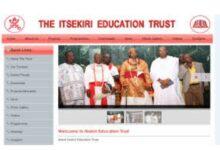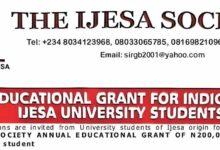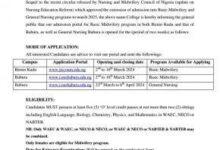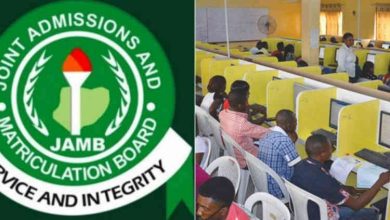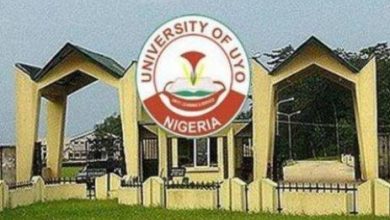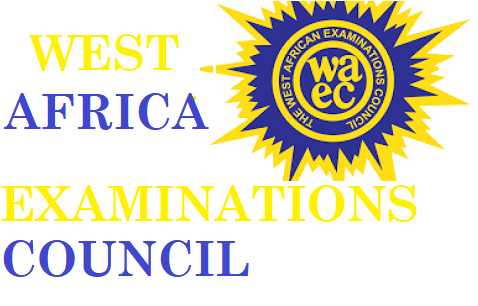
WAEC Syllabus for Mining
WAEC Syllabus for Mining. WAEC Syllabus for Mining is available for all candidates who want to participate in the examination. The West African examination council (WAEC) has officially introduced a syllabus that will guide all the WAEC candidates who wish to write the WAEC examination this year. For a very successful WAEC Mining examination for this year, you need to check out the available areas of concentration. It has been divided into sections with chapters, followed by the topics to be covered in preparation for the exams. In the WAEC Syllabus for Mining, you will also see the format of how the WAEC Mining questions will be presented. Jamb form
There are always 3 sections to answer questions from. Paper 1 is objective 2 and 3 contains essay questions. Where paper one (1) carries 50 marks and last for 50 minutes (2) carries 70 marks and last for 1 hour 40 minutes while paper three (3) carries 80 marks for 2 hours. WAEC Syllabus for Mining
👉 Relocate to Canada Today!
Live, Study and Work in Canada. No Payment is Required! Hurry Now click here to Apply >> Immigrate to Canada

This WAEC syllabus is for both the O’level WAEC and General Certificate Examination (GCE) candidates. Final year students in the senior secondary school level and external candidates are eligible to make use of this syllabus and prepare ahead of the examination. Dollar to Naira Rate
See the full detailed information concerning the WAEC Mining Syllabus below.
PREAMBLE
This syllabus is designed to evaluate the candidates’ knowledge of the basic principles and practices in the mining industry with a view to developing their interest in the business of mining. It provides opportunities for the acquisition of comprehensive knowledge, attitudes and skills which will stimulate students’ entrepreneurial interest and practice in mining.
AIM AND OBJECTIVES
The examination will test candidates’ ability to: Jamb form
- explain the basic concepts associated with mining;
- acquire the basic knowledge of rocks and minerals;
- recognize the special properties and values of gems and precious minerals;
- explain the methods of extraction of minerals;
- explain the processing of minerals to useful products;
- appreciate the importance of health, safety and environment in the mining industry;
- develop requisite skills for, and business attitudes to mining.
FIELD WORK
The students should be exposed to field work through excursions to mining industry sites such as coal mines, oil derricks, petroleum refineries, industries, oil spill sites, comminution sites, tailing sites etc on which they should be examined as part of their continuous assessment in schools. The scores for the field work should account for 40 percent of the total continuous assessment scores of the students that will be forwarded to the examining body. Waec Result
EXAMINATION SCHEME
There will be two papers-1& 2 both of which must be taken as a composite paper in one sitting for a duration of 2 hours 45 minutes.
👉 Relocate to Canada Today!
Live, Study and Work in Canada. No Payment is Required! Hurry Now click here to Apply >> Immigrate to CanadaPaper 1: will consist of forty multiple choice objective questions all of which are to be answered in 40 minutes for 40 marks.
Paper 2: will comprise two sections, Section A and Section B as follows:
Section A: will consist of 10 short structured questions covering the entire syllabus. All the questions should be answered in 40 minutes for 40 marks.
Section B: will consist of five essay-type questions from which candidates are to answer any three questions for 60 marks in 1 hour 25 minutes.
DETAILED SYLLABUS
| CONTENTS | NOTES |
| (A) INTRODUCTION TO MINING
|
(a) Meaning and branches of mining (b) Terminology used in mining (c) Classification and importance of minerals (d) Distribution of minerals in Nigeria (e) History of mining (f) Mining activities in Nigeria (g) Importance of minerals to man and national economy |
| CONTENTS | NOTES |
|
(B) BASIC GEOLOGY
(C) STAGES OF DEVELOPMENT IN MINING (BASIC CONCEPTS)
|
(h) Minerals markets and cartels (i) Mine accounting and sources of finance for mining ventures (j) Aspects of Nigerian minerals and mining Act, 2007 (k) Mining titles acquisition
(a) Definition of Geology and its scope (b) Relationship between Geology and Mining (c) Structure of the Earth (d) Relative abundance of elements in the Earth’s crust (e) Economic mineral potentials of Nigeria (f) Rocks and rock types ( igneous, sedimentary and metamorphic) (g) Rock-forming minerals (h) Physical and chemical properties of rock-forming minerals (i) Rock cycle (j) Weathering (k) Simplified geological map of Nigeria (l) Mineral map of Nigeria (m) Collection and collation of geological data (n) Interpretation of topographical and geological maps (o) Drawing of simple geological cross-section
(a) Classification of mining methods ( Surface and underground mining methods) (b) Choice of mining methods: Reasons for choosing surface or underground mining methods (c) Surface mining methods: quarrying, open pit mining, open cast mining, alluvial mining etc (d) Underground mining methods: room-and-pillar, longwall, cut-and-fill, shrinkage, block caving, sub-level etc (e) Comparison of surface and underground mining methods (f) Justification of choice of methods (g) Prospecting stage: meaning and outlines of prospecting techniques e.g. geological technique, geophysical technique, geochemical technique, remote sensing technique (h) Exploration stage: meaning and classification of exploration techniques (e.g. geological technique, geophysical technique, geochemical technique, remote sensing technique) (i) Meaning of feasibility study of a mining venture (j) Financial analysis in mining (k) Meaning of a mine, mine development, mineral processing design, mill design, mining as actual exploitation, list of unit operations in mining e.g. drilling, blasting etc. (l) Need for mineral processing, economic benefits of mineral processing, list of unit operations in mineral processing (m) Meaning and processes of metal extraction e.g. smelting (pyrometallurgy), hydrometallurgy and electrometallurgy |
| CONTENTS | NOTES |
| (D) MINING METHODS
(E) INTRODUCTION TO MINERAL PROCESSING
(F) GEMOLOGY AND LAPIDARY
|
(a) Surface mining methods:
(i) open pit as an example of surface mines, features of an open pit mine, minerals mined by open pit method
(ii) Open cast mine as example of surface mine, features of an open cast mine (iii) Quarrying and Dimension Stones production: Meaning, products of quarrying, uses of products, unit operations of a quarry, flow sheet of the operations of a quarry (iv) Dimension stone production (vi) Minerals that are mined by open cast method
(b)Underground mining methods: (i) Features of an underground mine (ii) Basic concepts of underground mining methods e.g. square setting, cut-and-fill, shrinkage, sub-level, long-hole, open long-hole, block-caving, open- cut (c) Sea-floor mining (d) Moon and asteroid mining (e) Materials handling equipment e.g. conveyor belt, trucks, pay-loader etc Npower Recruitment
(a) Meaning of: Mineral processing, comminution terms, concentration terms, mill accounting terms (b) Properties of minerals employed in mineral processing e.g. specific gravity, magnetism etc (c) Main operations in mineral processing i.e. comminution and concentration (d) Products of mineral processing e.g. concentrate and tailings, middling (intermediate product), dewatering in mineral processing, auxiliary operations, tailings disposal
(a) Meaning of gemology and lapidary (b) Machines and tools in gemstone processing e.g. faceting machine, grinding machine, polishing machine, etc (c) Meaning and properties of gemstones (d) Types of gemstones based on shape, colour, size, refractive index etc. (e) Characteristics and methods of identification of gemstones; quality of gemstones (f) Unit of measurement of gemstones, prices of gemstones (g) Marketing and prices of gemstones
|
| CONTENTS | NOTES |
| (G) HEALTH, SAFETY AND ENVIRONMENT
|
(a) Health hazards in mining
(b) Safety requirements/measures in mining (c) Impacts of mining on the environment (d) Safety equipment and apparels used in mining – personal protective equipment (PPE) (e) Common diseases associated with mining industry (f) Administering simple first aid, drugs/ dressing material (g) Guidelines for accident reporting, steps for environmental control (h) Basic issues in National policy on mineral development (i) Mining laws and regulations (j) Environmental protection laws (k) National policy on the environment |
LIST OF FACILITIES AND MAJOR EQUIPMENT/MATERIALS REQUIRED
| S/N | DESCRIPTION | QUANTITY |
| 1 | Spring balance | 2 |
| 2 | Fire extinguishers | 1 |
| 3 | Sand and water bucket | 1 |
| 4 | Specific gravity test apparatus(pycnometer) | 2 |
| 5 | Model of open pit mine | 1 |
| 6 | Model of underground mine | 1 |
| 7 | Samples of common rocks and minerals e.g. limestone, cassiterite | 5 |
| 8 | Samples of gemstone | 5 |
| 9 | Globe | 1 |
| 10 | Petrological microscope | 2 |
| 11 | Binocular microscope | 2 |
| 12 | Magnifying glass | 10 |
| 13 | Topographical maps | 5 |
| 14 | Geological maps Dollar to Naira Rate | 5 |
| 15 | Chart of periodic table of elements | 1 |
| 16 | Thermometers | 5 |
| 17 | Electronic balance | 1 |
| 18 | Beakers | 5 |
| 19 | Cylinders | 5 |
| 20 | Petri dishes | 5 |
SUGGESTED READING LIST
Damisa, E.O.A. (2010): Introduction to Mining, published by Spectrum Books Ltd.
Gregory, C.E. (1983): Rudiments of Mining Practice, Trans Tech Publications, Zellerfled- Germany.
Damisa, E.O.A. and Tsaro, G.D.A. (2011): Introduction to Mineral Processing, Published by Spectru Publishers.
Davou, D.D. (2012): Introduction to Geology, Published by Spectrum Publishers.
Mallo, S.J. and Nwude, B.O. (1998): Introduction to Shaft Sinking.
Mallo,S.J. (1998): Minerals and mining on the Jos Plateau. Published by ACON, Jos.
Hartman, L.M.(2002):Introduction to Mining Engineering.
Fred, B.G & Laurence J.D.(2006): Mining and its impact on the environment.
Wills B.A. &Munn,T.N. (2006):Wills Mineral Processing Technology. Published by Elsevier.
Fuestenau M.C. & Han, K.N. (2003): Principles of Mineral Processing, Published by Society of Mining, Metallurgy and Exploration. Npower Recruitment
Hartman, L.M. (1992): SME Mining Engineering Handbook, Vol. 1 & 2, Second Edition.
Littleton, Colorade: Society for Mining, Metallurgy and Exploration Inc(SME).
Mukerjee, P. K. (2005): A Textbook of Geology. Kolkuta. The World Press.
Chermcoff, S. & Whitney, D. (2007): Geology: An Introduction to Physical Geology. Fourth Edition. Pearson International. New Jersey.
Check and Confirm: How much is Dollar to Naira Pounds to Naira Rate Today
